|

|
|

|
|
|
|
During the past ten years I
have been involved in skating performance testing of individual hockey
players and hockey teams from all over the world. This testing was
part of a very comprehensive study that
analyzed skating performance in 14 basic game fundamentals.
Representing some of the International participants were players from
Korea, Japan, Germany, Switzerland, and England. Representing North
America were players from Alaska, Michigan, California, British
Columbia, Alberta, Saskatchewan, Manitoba, and Ontario.
Players tested have ranged from Professional (North American and
European), to the Canadian Olympic program. As well, all levels have
been tested at the amateur levels, from beginner to Junior.
The database that was created represented quite a diversity
of players. Players tested ranged from 4' 6" to
6'5" as well as from 65 to 240 lbs. All positions including
goal-tenders have been tested. This information has been analyzed very
extensively.
I will endeavor to put this
testing analysis into a visual format that will create a clear picture
of the relevance as well as the application of the testing process.
Skating
is the foundation of the game. How much so to date has not been clearly
understood.
- Are goal scorers better
skaters or is it just their ability to read the play and shoot
accurately?
- What skating skills are predominant to successful teams and players?
Is it overall speed or acceleration or the ability to change direction
quickly that really matters?
- How important is the training of backward skating fundamentals so as
to create a balance training environment?
- How important is a player's ability to react?
- How does reaction time equate into space or open ice?
- What is the difference between the average and the best skater
relative to
space?
- Within a team structure, what is the relevance to accumulative skating
skills of all player's within tactic system implementation?
- If the testing identifies a weakness in my team or a specific player
what can I do about it?
Shown
below are some of the tests that were performed. While testing is
diverse and further information regarding these tests can be attained
through the parent company Quan-Tech Sports Inc. I have chosen only the
ones explained below. While the tests are very simple and
specific, the relevance of these tests and their subsequent impact on
the game both from an individual as well as from a team perspective. is
dramatic. I have made the explanations very brief since I
feel that too much technical "babble" is not necessary at this
point. However, I have endeavored to provide enough
information to demonstrate each test's relevance to overall game
conditions.
They
are as follows:
Test No. 1 - Backward Crossover test; identifies strength /
weakness in:
- balance and technique (body alignment)
- edge control (skating efficiency)
which translates into the ability to:
- check effectively (angling skills - closing gap)
- create better play selections (opening ice while in possession of
puck)
Test No. 2 - Forward Crossover test; identifies strength
/ weakness in:
-
lower body strength and power
- leg strength and explosive power
- balance and technique (body alignment and foot placement)
- edge control (skating efficiency)
which translates into the ability to:
-
for effective lateral mobility
- change lanes effectively.
- support effectively
- drive to the net
- check effectively (angling skills - or man on man coverage)
Test No. 3 - Forward Acceleration test; identifies strength /
weakness in:
- explosive power
- leg speed
- edge control and technique
which translates into the ability to:
- react to or execute quick transitional plays
- react to quick movement of the puck
- check more effectively (close the gap)
- support more effectively (offensively and defensively)
Test No. 4 - Forward 60' foot sprint test identifies; strength
/ weakness in:
- technique (moving from quick accelerating into long striding phase)
-
change speeds
- leg speed
which translates into the ability to:
- accelerate properly during the transitional striding phase
- skate effectively in short distances
- check effectively (close gap - angling)
- change speeds
- react quickly to quick transitional plays
- take advantage of open ice
Test No. 5 - Forward Full Stride test identifies; strength and
weakness in:
- technique
- edge control and skating efficiency
- groin flexibility
which translates into the ability to:
- skate efficiently
- take advantage of open ice
- take advantage of offensive opportunities - break-a-way speed
- forecheck effectively
- back check effectively
- support effectively (join in the rush - defense jumping up into the
play)
Test No.6 - Backward Acceleration test; identifies strength /
weakness in:
- edge control and balance
- foot speed
- torso flexibility
which translates into the ability to:
- maintain the blue-line in the offensive zone
- react to quick breaks or transitional plays
- maintain gap
- support effectively (for defensive during def. - to - def. passing
options)
- create better offensive opportunities (coming to middle off the wall
in
offensive zone - point man)
Test
No.7 - Backward Full Stride test; identifies strength / weakness
in:
- body alignment, edge control and balance
- technique
- flexibility (hips)
which translates into the ability to:
- maintain backward skating speed
- maintain gap
- check more effectively
Test No. 8 - Tight Turn test; identifies strength /
weakness in:
- body alignment, edge control and balance
- leg and ankle strength
which translates into the ability to:
- react to quick transition plays (stay involved in the play)
- react to quick movements of the puck
- get open under intense checking conditions
- work effectively down low
- be more effective on specialty teams
- check more effectively - maintain and / or close gap
- create better offensive opportunities (delay options)
Test No. 9 - Pivot Backward to Forward test; identifies
strength/ weakness in:
- body alignment, edge control and foot speed
- flexibility
- technique
which translates into the ability to:
- react to dump in plays
- check effectively (forwards driving to outside)
- react to quick movements of the puck
- face the play
Test No. 10 - Pivot Forward to
Backward (direction change) test; identifies strength /
weakness in:
- body alignment, balance
- foot speed and edge control
- technique
which translates into the ability to:
- react to quick transitional plays
- keep up on the play (offensive blue-line)
- maintain gap (positioning)
- face the play
Test No. 11 - Stop and Start test; identifies strength /
weakness in:
- body alignment and balance
- edge control
- leg and ankle strength
- explosive power
- technique
which translates into the ability to:
- react to quick transition plays
- react to quick movements of the puck
- get open under intense checking conditions
- work effectively down low
- be more effective on specialty teams
- check more effectively - maintain and / or close gap
- create better offensive opportunities (delay options)
Test No. 12 - Agility test; identifies strengths / weakness in:
- body alignment and balance
- edge control
- foot speed
- technique
which translates into the ability to:
- attack effectively
- create superior offensive opportunities
- react to quick movements of the puck
- check more effectively
Test No. 13 - Backward / Forward Stop / Start test; identifies
strength / weakness in:
- body alignment, edge control and balance
- explosive power
- foot speed
which translates into the ability to:
- react to quick transitional plays
- react to quick movement of the puck
- face the play
- check more effectively (maintain and/or close gap)
Test No. 14 - Pivot Backward to Forward (direction change) test;
identifies strength /
weakness in:
- body alignment and balance
- edge control and foot speed
- technique
- flexibility (groin and hips)
which translates into the ability to:
- react to quick transitional plays
- react to quick movement of the puck
- face the play
- check more effectively (maintain and/or close gap)
How
each player uses his assets and protects his liabilities dictate his
success story - not with-standing heart and desire.
Ron
Johnson
.
|
|
I have
provided some of the technical considerations that as an instructor I
must evaluate
and correct before a
player can
perform skill function to its
maximum
potential.
Crossover
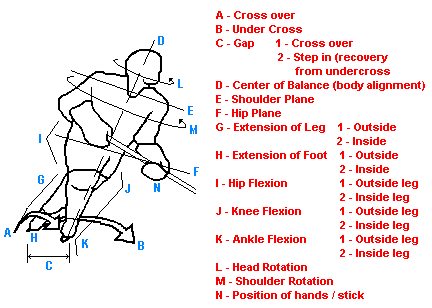
Forward "V" Start Acceleration
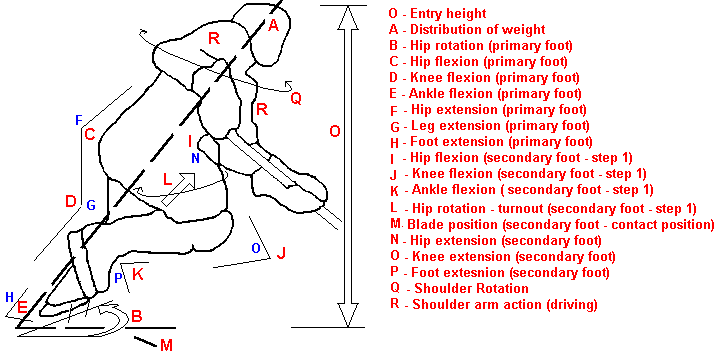
Forward "V" Start - Top View
Forward Striding Front View
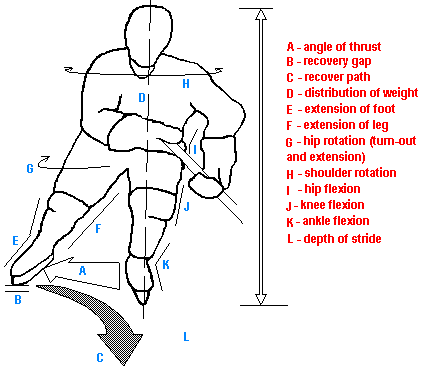
Striding - Top View
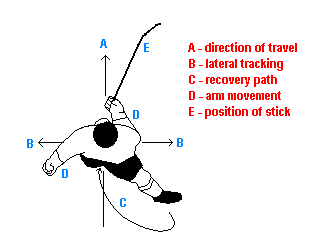
Backward Striding
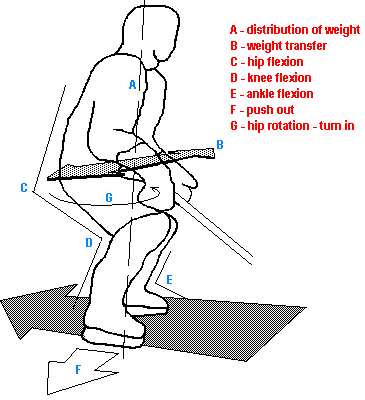
Backward Striding - Back View
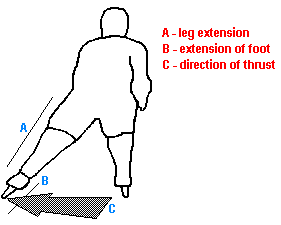
Gliding Turn
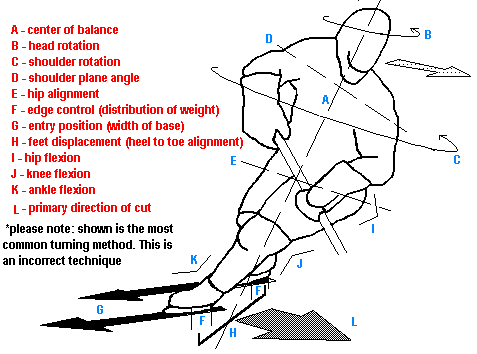
Forward Parallel Stop
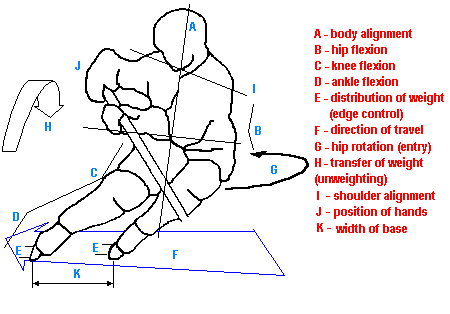
Forward to Backward Pivot - Direction Change
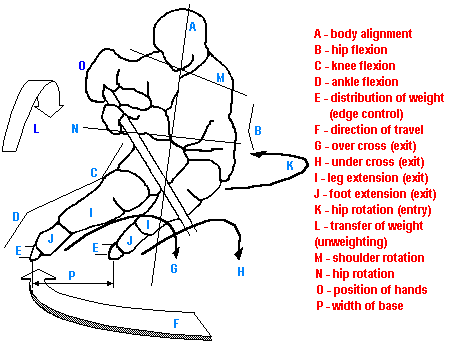
|
Each fundamental is critical to a player's success during game play. One-on-one confrontations create
a very competitive environment where the player with the "edge" has greater success. This "ballet"
of inter-action between players creates situations where weaknesses and strengths become evident.
When neutralizing an opponent or "getting open" a player will quickly realize how well he utilizes his
strengths and how well he protects his weakness.
In the hockey world where games and careers are won and lost, these player attributes become quite
literally, either an asset or a liability.
However,
in society today we tend to view testing as a negative experience. It
seems that information is constantly being used against us. When I was testing
in Switzerland, several players coasted through the tests and I had to
send them off the ice and delete their times so as not the skew the study.
They felt that the owner ship was going to use the information against them for
contract negotiations. On the other hand, most of the players wanted the
information so as to focus on their development. They were true
competitors. The information allowed them to identify where they ranked
against other players at their own level and target their off and on ice
development to maximize their skill.
When I
tested the Seibu Bears from Japan, they asked for a complete report on all
players; how they ranked relative to each other as well as how their data
effected team performance.
It is
entirely up to the player as well as the coach, the quantity and quality of
information that they wish to see.
The
following is a player model which I will call player "X". The
objective is to give you an example of how the information creates a performance
model.
In order to give a better assessment of a player's ability I have created a ranking system based on a scale
of 0 to 10 (based on actual percentile).
Since default rankings are against total relative division player pool, the higher the score that a player
attains overall, the better the player's ability to contribute to his team through his skating skill. If a player
competes at the Junior A - Tier II level, he is only compared to players at that level unless otherwise
specified.
This allows us to better assess his "assets and liabilities". These assets are broken down into backward
skating fundamentals and forward skating fundamentals. For example:
Backward Skating Assessment for Player "X"
Test Description
Time Percentile Rank
1 Backward Crossover
10.65
6%
.6
2 Backward Crossover
10.59
9%
.9
3 Backward Acceleration
2.10
56% 5.6
4 Backward Full Stride
5.61
28% 2.8
5 Backward/Forward Pivot-L
3.41
64% 6.4
6 Backward/Forward Pivot-R
3.53
38% 3.8
7 Forward/Backward Pivot-L
4.40
80% 8.0
8 Forward/Backward Pivot-R
4.28
98% 9.8
Average Ranking
47% 4.7
Forward Skating Assessment
A Forward Crossover - L
8.52
50% 5.0
B Forward Crossover - R
8.22
77% 7.7
C Forward Acceleration
1.54
80% 8.0
D Forward Transition Stride
2.59
97% 9.7
E Forward Full Stride
4.29
70% 7.0
F Tight Turn - L
3.69
98% 9.8
G Tight Turn - R
3.41
99% 9.9
H Stop/Start - L
3.16
99% 9.9
I Stop/Start - R
3.40
98% 9.8
J Agility without puck
4.79
57% 5.7
K Agility with puck* Not included in this assessment
Average Ranking
82.5% 8.25
Using Player "X's" scores we can clearly identify his strengths (assets) and weaknesses (liabilities) using
game applications.
An understanding of the physics and methodology of skating fundamentals helps to pin-point the cause and
effect in relation to his scores.
Skating can be broken down into 2 basic categories and can be demonstrated as follows:
Technical Attributes
Physical Attributes inherent in skating
1. Balance
1. Static strength
2. Body alignment
2. Explosive Power
3. Foot Speed
3. Quickness
4. Edge control
4. Flexibility
5. Technique
5. Muscular endurance
As well as Aerobic and Anaerobic Capacities.
Each test is designed to specifically target one or a combination of these
components.
When we further analyze Player "X's" times and rankings we can gain a clear picture of not only his
skating style but his physical structure as well.
Player "X's" low ranking in backward crossovers (T1- 6-9%) can be attributed to poor body alignment and
balance (upper body bent to far over is one of the most common problems). Poor upper body alignment
causes slippage off the front part of the skate, especially the inside foot / outside edge minimizing power.
This is also evident in the backward acceleration test (T6 - 56%) where scores are again low. Low scores
in the backward full stride (T7-28%) are again the result of poor body position as well as poor technique (improper C-cuts and hip rotation or turn in is one of the most common
problems).
Knowledge of the "cause and effect" of skating deficiencies allows us to cross-examine Player "X's"
evaluation report. From the information provided in the report we can see that this player does not work
on his backward skating. An important game skill is the ability to face the play. Once identifying Player
"X's" problem as being weak backward skating we would then study his game play to see if he turns his
back on the play.
This critique is further substantiated by his forward skating assessment.
When assessing Player "X's" forward skating ability we see further evidence of his bent over skating style.
A bent over skating style during forward crossovers (A/B - 50-77%) again results in loss of power from the
inside leg/outside edge. This is also apparent during the agility test (J - 57%) where scores are again
average. Poor body position contributes to a problem moving laterally side to side within the 16'6" distance
between markers. Any slippage off of the inside foot limits power bringing the body back over center. It is
evident that this player does not feel comfortable bringing his skates back and forth across his body or into
his center.
His skating style is that of a winger - adhering to a "keep in your lane coaching
philosophy" or a player that is a habitual straight liner, working his way
down the ice in a series of straight line attacks. Forward acceleration scores
(C - 80%) demonstrate that his forward acceleration is good, the result of short powerful
strides which allow him to attain a very good score in the medium distance sprint test
(D -97%) distance. The 60 foot test measures a player's skating ability through the transitional phase from accelerating to full open-ice striding.
Good full striding technique requires complete extension of the leg and foot as well as proper recovery
position under the body on the outside edge. The drop-off of his score in the full stride test
(E - 70%) shows that he does not complete his stride to full extension (most common problem with full striding
technique) and is a wide tracker (does not bring his recovery leg back under his body - outside edge).
Upon completion of the analysis we can now rate this player on his strengths and weaknesses and answer
the following important questions:
How can he contribute to his team? How effective is he? How does he use his strengths (assets)?
How well does he protect his weaknesses (liabilities)?
Player "X's" overall skating strengths and weaknesses are by-products of his position. This is evident by
poor backward skating fundamentals. As a forward however his skating skills are valuable assets. High
tight turn and stop/start scores enable him to be successful down low. These skills enable him to
react quickly to transition and puck movement allowing him to keep involved in the play. He can work both
sides of the ice well which would make him a valuable asset on specialty teams. However, his bent over
skating style, poor backward skating and dependence on his tight turns limit his ability to face the play
which could make him a liability on the penalty unit. As well, tactics that
utilize lateral movement (crossovers) would suffer as well. While
possessing good speed , a valuable asset when driving to the net or forcing the
puck carrier, situations where angling is necessary become compromised and
success is limited.
Scores high in tight turns (F/G - 98%), stop/starts (H/I - 98%) and forward acceleration
(C - 80%) identify good leg strength, explosive power and leg speed. These skills are critical components of good checking
and hitting fundamentals.
Further
analysis can be done by cross-referencing more of the information.
However, space is limited and at this time it is not prodent to do so. Any
questions that you may have can be directed to me personally.
SEE
RESEARCH SECTION. for more information.
Link to Products and Services
for complete player evaluation and digital analysis
Testing - Team System Relationships
The C.A.T. system of test / retest follows a set progression derived from game situations, moving players
through a chronological process from testing, analysis, correction and training. For example:
1. Identifying game inherent skills; tight turns, stops and starts, etc.
2. Testing game skills; tight turns, stops and starts
3. Analyzing information: feet per second, player potential.
4. Providing an environment for improvement: knowledge leads to better practice planning.
5. Teaching of fundamentals in a skill specific environment.: Utilizing the practice.
6. Adding pressure to skills: competition drills to create game situations.
7. Identifying game theory applications and executing in a practice environment: cycling, delay options, etc.
8. Playing of games to assess strengths and weaknesses: 2-on-2, 3-on-3, down low mini-games.
In order to understand the relevance of the information presented in the previous chapter we must create a link
between each specific skating analysis and its game application. Hockey can be broken down into 2 basic
skating systems:
1 - those skills involved in the short game (30 feet and under)
2 - those skills involved in the long game (30 feet and over).
In this chapter we will establish the relevance of distance, speed and skill and how testing can help to pinpoint
weaknesses in individual as well as team play.
In diagram no. 1 we are trying to create an environment where we can directly analyze a player's skill level not
only at a personal level but at a team level as well. The above diagram represents a game situation in 3 stages.
1 - Team has initiated a break-out option to the near side with the center supporting.
2 - Lanes have been filled with players supporting each other as the puck moves through the neutral zone.
3- Puck has moved into the offensive zone with puck carrier initiating a delay option play, with support down
the near wall and a late man moving up on the play.
In each zone specific skating skills are inherent to the success of the team's operating system.
1 - Defensive zone: quick acceleration. Capitalize on opponents' static positioning. Quick acceleration in the
form of crossover starts, running or "V" start, as well as accelerating through a curve (crossovers).
2 - Neutral zone: maintaining speed through angular cuts or straight ahead.
3 - Offensive zone: de-acceleration, slowing down, stopping, delaying, tight turns, Once attack has lost
momentum, players again resort to short game skill and speed.
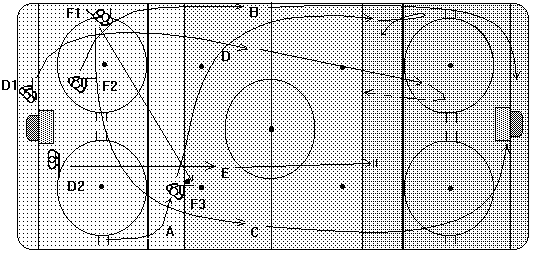
We must
break down the above diagram to understand game to practice to testing
relationships.
Diagram
No. 1 represent Defensive zone player movement. Diagram No. 2 represents
breakout practice.
Diagram No.
1
Diagram No. 2
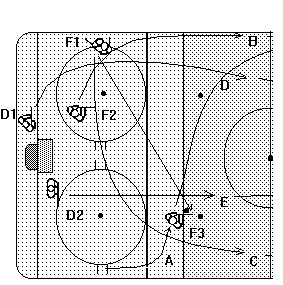
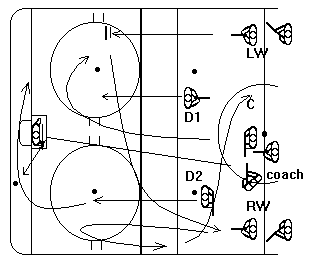
Diagram
No. reflects tests that mimic player movement relative to game and practice
enviroments.
Diagram
No. 3
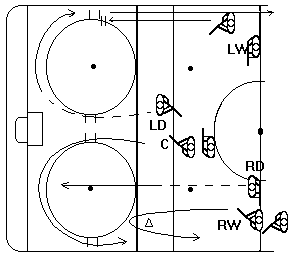
Diagram No. 1 shows only the defensive zone excluding defensive players. Lines in the diagram
represent movement of players (skating patterns):
D2 initiates play with pass to near side winger F1
F2 is in a support position
F3 skates into gap in neutral zone and receives pass
D2 is in support position in front of net
Players move out of defensive zone into neutral zone with speed filling lanes.
Diagram No. 2 shows a basic drill to mimic above game situation.
Coach dumps puck on net and players breakout by moving into proper support positions.
Lines represent movement of players (skating patterns)
Diagram No. 3 isolates skating components inherent within the breakout system. Each position has basic
skating fundamentals that are required to make the breakout successful. While isolated by position, all
players should be able to execute these skating fundamentals well.
Shown per position - skating component and corresponding C.A.T. Test
Left Winger: Stop/Start
CAT Test:
Left Def.:
Back/Forward Pivot CAT Test:
Right Def:
Back/Forward Pivot CAT Test
Centre:
Forward Crossover CAT Test
Right Wing: Tight Turn
CAT Test
Diagram
No. 4 Neutral Zone
Transition
Diagram No. 5 Practice Simulation
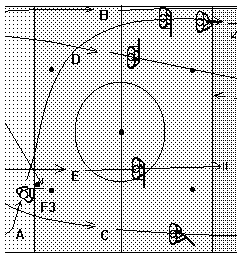
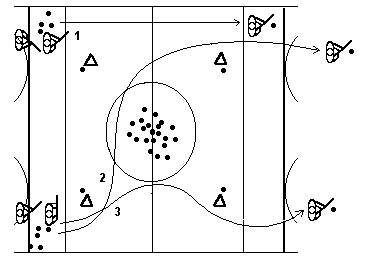
The
diagram below reflects CAT tests:
A -
Forward Full Stride Sprint Test B - Forward Crossover
Test C - Forward Full Stride Puck Carry D -
Agility Test
Diagram
No. 6 Testing Simulation
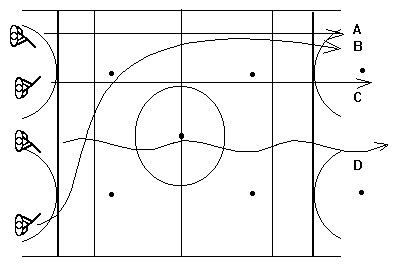
Diagram No.
4 represents phase 2 : the movement of players through the neutral zone. It is through this
zone where maximum speed is attained in this type of situation.
Diagram no. 5 represents player movement through the neutral zone and the Excel corresponding tests.
A - Forward Transitionary CAT Sprint Test
B - Forward Crossover CAT Test (skill isolated)
C - Forward Full Striding CAT Sprint Test
D - Forward Agility CAT Test (with and without a puck)
Development -
Testing Team Development Relationship
In order for a player to maximize skating potential, a series of drills must be implemented during the
practice format. Most "power skating" developmental exercises can be used. Certain exercises are used
during power skating and can be utilized during practice. It must be remembered that power skating
programs are short, intense training sessions that focus on one or many skills. This is due to
the pressure to maximize development of all skating skills in a short period of time due to the costs involved. At 50$ to
200$ per hour, players and parents expect results in all areas of skating in a very short
period of time. At the amateur hockey level we have strayed away from form correction during the practice
format and focused more on system implementation. . This is due in part to a lack of knowledge of skating techniques. However, drills can be used that
will accomplish results just by "doing" them without the pressure on the coach to be the "expert".
One of the most basic and most important components of skating is balance and edge control. While all
hockey players exhibit good balance, edge control is a major problem. This is due to either ankle strength,
poor body alignment or even miss-alignment of the blades on the boot. This problem should be checked
every time a new pair of skates are purchased. In most cases, the blade is mounted incorrectly creating an
inside edge dominance. Both fundamentals can be enhanced by performing a simple exercise for a couple
of minutes a practice. In the diagram no. 1, a player is skating through the neutral zone balanced on one
leg zig-zagging back and forth from inside to outside edge.
This drill will be difficult for younger players but should be done no matter the age. Increasing levels of
difficulty enhance the training effect. Increasing speed as well as movement from side to side to jumping
and landing on alternating edges will achieve maximum results. This drill should be performed both
forwards and backwards.
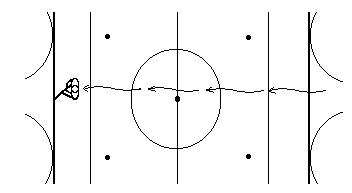
The
following diagram represent one leg balance and edge control used in above
drill.

Key teaching points:
- keep knees and ankles flexed. (A and B)
- keep weight aligned properly; shoulders over knees, knees over toes. (D)
- keep head erect and stomach/abdominals tight.
- extend leg (straighten) on thrust (inside and outside edges) and flex on
recovery (transferring edges)
Perform at the beginning of practice for several minutes both backwards and forwards.
Once
testing has identified problem areas, how can coach's set about implementing a
developmental plan that addresses player's or collectively, team weaknesses?
The
drill variations demonstrated below are basic formations for developing proper technique. Inherent in each drill are
components that are critical to it's successful execution in a game environment. Power skating instructors have utilized a language that, much
like hockey coaches within the game and practice environment, address these components. Terms such
as gliding leg, skating leg, knee and ankle flexion, and recovery gap depict visual models for correction.
During power skating camps, players execute the above maneuvers once correct form has been
demonstrated, while receiving verbal cues from a professional. The problem with most amateur and even
professional coaches is that they do not consider themselves knowledgeable enough to make these verbal
corrections. They instead are more concerned with movement within the drill itself speaking in terms of
space and speed as opposed to technique.
However, if a player executes the above mini-drills enough, noticeable improvements will result. Since the
majority of these drills represent short game play, reaction time will improve. Overload training will also
occur due to the forces placed on the thighs and gluteals during the crossovers, stop - starts, and tight turns.
Players not only will improve their technique but will become stronger as well.
What is necessary then is to identify how to place the above mini-drills effectively within a normal practice
environment. A normal practice environment is one that deals with team systems as opposed to isolated
player skill development as incorporated by hockey and skating schools.

The
diagram demonstrated below is a common swing drill used by many coaches. It has been given many names from
"horse-shoe to St. Louis" but is a basic swing with players skating down the wall, swinging through the top
of the zone to receive a pass from m the corner and then proceed down the ice to take a shot on the net.
Using a format of 15 skaters (3 full lines) we have work to rest ratio of 1:7.5.
The drill incorporates approximately 200 feet of straight line skating with a low load crossover swing
across the top of the zone with minimal crossover activity attacking the net. What we want to accomplish
through modifying the drill is to increase crossover and tight turn development
which has been identified as a team weakness, as well as to increase work to rest ratios.

This
basic drill can be "spruced up" to add necessary components. For
example:
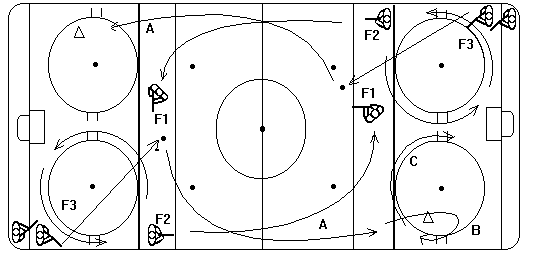
All tests
identify inherent game skills. Once weaknesses have been identified, developmental
components have to be implemented. Testing -
development integration is my area of expertise. Questions and
comments can be addressed via E-mail regarding information posted on this
page. There is much more information that unfortunately I cannot post here
due to volume of content but will endeavor to make available as time and space
permits.
Testing
Prices
Ron
Johnson, President, Technical Director Quan-Tech Sport
Systems Inc.
Copyright © 1996 by Ron Johnson. All rights reserved.
Revised:
04 Nov 2009 08:40:24 -0800
.























